Driving in Japan
Japan has highly efficient public transportation systems including its unrivaled rail network, with high-speed, intercity, local and subway trains connecting many popular destinations. But outside the cities, public transport can sometimes be inconvenient or not frequent enough (like Okinawa, Takayama, Nagano, Hokkaido), that is where you need a car to get around.
Remember, Japan has a number of amazing scenic spots that can only be reached by a car. If you want to enjoy greater range and flexibility and visit places with spectacular scenery, whether it’s a ski resort, beach or hot spring renting a car is a very nice idea! You will be able to see the destinations that most other travelers do not get to see. Many people imagine that driving in Japan is very difficult, but don’t worry! In fact, it’s much easier than you think! In this guide, I will give you the information that can help you enjoy a blissful trip to Japan from the driver’s seat. So, let’s get into the details.
Booking a car
How to book a car when taking a road trip to Japan?
There are four simple steps:
- Choose your route and the car model
- Fill in your order details
- Complete your reservation
- Pick up your car at the store
How to choose a car that meets your needs?
The type of car that you want to choose would depend on various factors such as the number of people (adults, children), the season, how long will you be driving, how much luggage you will have, etc.
In Japan, you will be able to rent all kinds of vehicles, from the most basic to roomy and luxurious SUV. If you do not have any special needs go for the cheapest option, especially if you are on a budget. If you have a child with you make sure to equip the vehicle with a safety seat.
Obviously, if you are going someplace that’s covered in snow a 4WD vehicle would be the best choice. Make sure it’s equipped with winter tires. Additionally, snow chains might come in handy too.
If you travel with your family you can get a larger car. For long distances, you would appreciate having a more luxurious vehicle. It can make the trip more comfortable, especially if you plan on having long-distance journeys or fewer stops.
How to choose insurance?
Major car rental suppliers in Japan usually include liability insurance and damage insurance in their basic contract. However, in case of an accident, insurance companies will pay the amount up to a certain limit. Be aware you will also be required to pay the deductible. If you get a CDW you will be exempt from paying the deductible. However, if you damage the car due to negligence, for instance driving on a beach that has no road for cars, you will still be required to pay deductible together with Non-Operation Charge (NOC), which is compensation for the time during which the car rental company cannot rent out the vehicle because of damages.
You can buy the insurance:
- Online when booking the vehicle (recommended)
- At the service counter of your rental car supplier
- Or from a third-party insurer
Some personal car insurances extend to rental car as well. You may already a basic insurance plan, but you should be careful as there are some exceptions. The validity of your policy will largely depend on the location of your travel. It is usually unlikely for such policy to extend in faraway countries.
Some travel credit cards do include the basic insurance for your car rental, even when traveling abroad. The best would be to consult with your insurance company/credit card provider and see if they cover rental cars too. Even then, make sure that they don’t leave some parts of potential risk uninsured.
If your travel budget is sufficient, it is recommended to choose an insurance with the most comprehensive coverage, as repairing the car might be very expensive. Moreover, if you get injured, medical expenses and other related charges will also be high. And obviously, the better your coverage is, the lower your financial risk will be.
Picking up your car
Pick-up materials that you will need
| Item | Note |
| 1. Passport | Belonging to the main driver (if he/she does not have a Japanese driver’s license). |
| 2. Driver’s License | Foreign travelers are required to present an International Driving Permit (IDP, based on the 1949 Geneva Convention).
OR an original driving license issued in Switzerland, Germany, France, Belgium, Taiwan, Slovenia or Monaco – TOGETHER WITH Japanese translation by an authorized organization. If you hold a Japanese driver’s license, you are not required to have an IDP. |
| 3. Credit/Debit Card | Credit or debit card. |
| 4. Pick-up Document | Offered by QEEQ.COM once the reservation is successfully confirmed. For many bookings electronic pick-up document is also available, which can be used to replace the paper version. |
Note: In order to drive an ordinary vehicle in Japan, you must be at least 18 years old. However, for certain types of vehicles higher minimum age limit is applied.
Other materials that you might need
- Offline navigation app: Tantu Map, provided by QEEQ.COM for free.
- Phone holder: Japanese traffic regulations forbid the use of mobile phones while driving. Recently the rules have become stricter, with steeper fines and possible prison terms. Consider, having a mobile phone holder with you.
- Child Seat: Proper safety seats for children under the age of six are required. Otherwise, drivers will face heavy fines, you can reserve a child seat online, ahead of your trip.
How to get to the store?
| On foot | If the store is nearby you can walk and simply follow the “car rental” signs. |
| By bus | If the store is far, usually there is a shuttle bus available. You may find the name/logo of the company for directions towards the bus station. |
| By requesting a pickup on the spot | If a shuttle bus is not available, you can dial the store number and wait for the staff to pick you up. If you have problems when communicating with the local staff, you can contact QEEQ.COM customer service for assistance. |
| By requesting a pickup in advance (staff waiting with a name board) | Some rental companies will provide meet and greet service. One of the employees will be waiting for you with a name tag. If you cannot find him/her, dial the store number. |
Things to pay attention to when picking up a car
- Bring all the necessary documents and ensure that you have a sufficient amount of money on your credit card.
The main driver is required to have all the relevant documents. The credit card must be issued in the name of the main driver. Also, you should verify that there is enough money on your credit card for pre-authorizing the deposit.
- Early pick up/Early drop off
In some cases, if you pick up your car earlier, you might be asked to drop it off earlier too. However, some companies might allow you to pick up the car in advance but return at the original drop off time. The rules also vary based on the location of the rental office. Make sure to inform the rental company in case you prefer to get your car before the scheduled time. Additional charges might be incurred.
- Registration of additional drivers
If there are additional drivers, make sure to provide relevant information and register them at the store. Otherwise in case of an accident, the insurance will be invalid.
- Car checking
Inspect the car carefully before picking it up. If some defect (even a small scratch) is found, it is necessary to show it to the staff and indicate the damaged location in the inspection voucher. It is highly recommended to take photos of those defects in order to avoid disputes when dropping off the car.
- Keep all the contracts and receipts
Make sure to keep all the contracts and receipts.
What to do if you are offered additional services and insurances at the rental counter?
- Compare the details of your contract and pick up voucher
When picking up a car at a store, the clerk may promote additional insurances and services. Before signing the contract, carefully check whether the estimated charge written in the rental agreement is consistent with numbers in pick-up voucher. Inconsistency might mean that they have added additional services in the list.
- You can reject any of the extra offers you don’t need
Extra insurances and services are optional. It’s up to you whether or not you want to have them. You can explicitly reject the ones that you don’t need. If you have any questions when negotiating with the store, feel free to call QEEQ.COM’ customer service for assistance.
Driving in Japan
Traffic rules and signs
Basic rules
In Japan, cars are driven on the left side of a road (i.e. steering wheel is located on the right side). Those from England, Australia, India, South America and other “left-lane” countries will have no difficulties related to the driving side. However, for those of you who are not used to driving on the left side, it might be more complicated, and it is of utmost importance to stay alert and never forget the correct side of your road when driving in Japan. Besides there are a few basic but important rules you should remember:
- Motorbikes are allowed to overtake you from your left. It is important to be attentive when moving from one lane to another.
- Ordinary roads have a speed limit of 60 km/h, unless stated otherwise.
- Highways have a speed limit of 100 km/h.
- You cannot turn on the red light.
- All passengers must have their seat belts on.
- Driving under the influence of alcohol or any other substance is strictly prohibited.
While driving in Japan you will also notice that if you let somebody into your lane they may respond by blinking their hazards few times. That means “thank you”. If you see hazards on a highway it might mean that the cars ahead have stopped. If you see this, slow down and turn on your hazards so that the person behind you also knows.
Important traffic signs
- Stop

- Slow down

- No entry

- Closed to motor vehicles (left sign); Road closed (right sign)

- No parking (left sign); No parking or stopping (right sign)

- Speed limit

- No U-turn

- No overtaking

- Railroad crossing

- Slippery road

- Steep road

- Stop line

- Bus only lane

- Pedestrian crossing

- One way

Roads & Fees
Tolls
Driving on a Japanese highway or expressway is in fact easier than driving on city streets. There is nothing to be afraid of, even if it’s your first time in Japan. An important factor that you should keep in mind is that the passing lanes are located on the right side of a road. It is not allowed to stay in the right lane for a long time.
Highways/expressways use ETC (Electronic Toll Collection) systems. In order to use an ETC card your car must be equipped with a special card reader. Using an ETC card can make your drive easier as the costs are automatically accrued on your card. In case of a rental car, you can pay the accrued fees at the end of your road trip. Those who have their own ETC card, the fees are automatically charged from the bank card that is attached to it (the credit/debit card must be issued by a Japanese bank).
Once you reach the toll gates you will see one of the three signs:
- ETC Only
- Cash Only
- ETC or Cash
You can choose the gate based on your payment preferences.
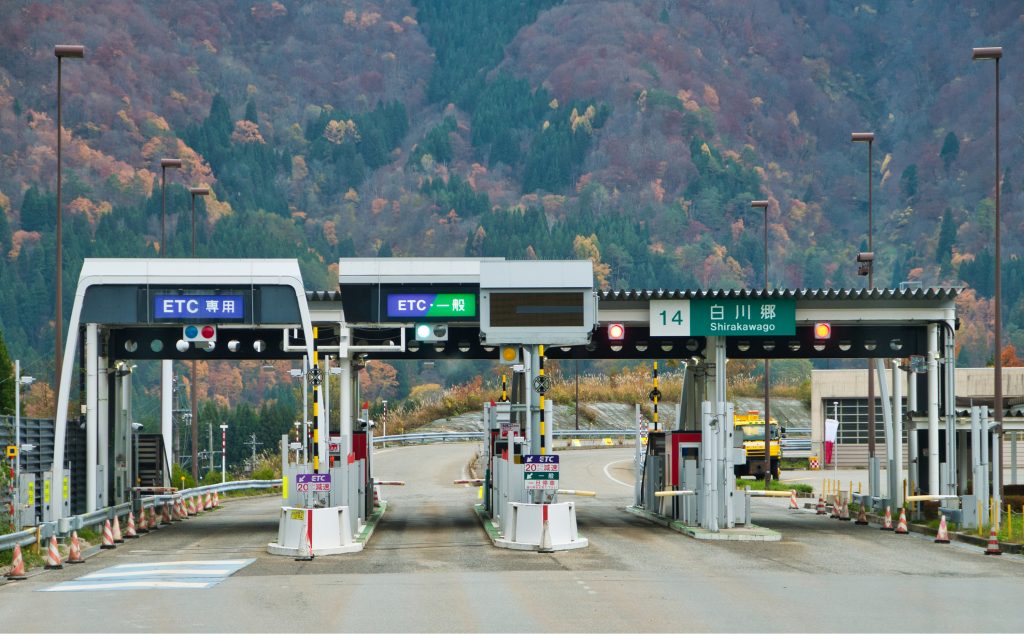

Highways and expressways are not that cheap! One thing you can do to lower your costs is to use Expressway Passes. To be eligible you must have a non-Japanese passport or have a permanent residence in another country. Expressway Pass can give you unlimited access to toll roads in the designated region/area. They use ETC system cards so you won’t need to strop at toll gates. If you are planning to rent a car for your trip, there is a high probability that the rental company can provide a relevant Expressway Pass (for a price of course) that can help you save money throughout your journey.
Expressway passes
There are various passes you could choose from:
- Japan Expressway Pass
It will enable you to use expressways in Japan as much as you like for a fixed price (only few expressway sections are excluded: Hokkaido, metropolitan Tokyo, metropolitan Osaka/Kobe and bridges between Honshu and Shikoku).
Prices:
7-day Pass: 20,000 yen
14-day Pass: 34,000 yen
- Central Nippon Expressway Pass (CEP)
Price range: from 5,000 yen to 16,000 yen
Optional Area – Nagoya Expressway Pass (NEP): +2,000 yen

Source: https://hayatabi.c-nexco.co.jp/cep/en/
- Hokkaido Expressway Pass (HEP)
Price range: from 3,600 yen to 11,300 yen

Source: https://en.driveplaza.com/area/hokkaido/pdf/e_hokkaido_drive_03.pdf
- Kyushu Expressway Pass (KEP)
Price range: from 3,500 yen to 11,500 yen

Source: https://global.w-nexco.co.jp/en/kep/pdfs/english.pdf
- Tohoku Expressway Pass (TEP)
Price range: from 4,000 yen to 12,000 yen

Source:https://www.driveplaza.com/trip/drawari/tep2015/pdf/TohokuExpresswayPass_en.pdf#view=Fit
Parking and refueling
Parking rates
In large cities parking is quite expensive, especially if you want to park in the center. Usually the fees range from 100 to 1000 yen or more depending on your location, day and time. In general, nighttime fares tend to be two to three times cheaper compared to daytime fares, however many parking lots in city centers, with busy streets full of cafes, bars and restaurants set expensive nighttime rates. Often shopping malls offer free parking as long as you buy goods from them and get a receipt. Touristic spots sometimes charge a fixed fee (~from 200 to 500 yen). In countryside and small towns, you can often park for free.
Parking lot types
You might be familiar with some types of parking lots in Japan but they also have some “irregular” parking lots which at first might seem unusual:
Parking lots with gates – in this kind of parking lot you take a ticket in the entrance by pressing a button on a machine located in the entrance (can be done from inside the car). It is very common in shopping malls. When leaving, you can insert the ticket in the special machine in order to pay your parking fee (which will be calculated based on the time you spent there). Alternatively, you can hand in the ticket to the parking attendant together with the payment.

Parking lots with locking flaps – these are open parking areas without a gate. Once you park the vehicle, a special device raises from underneath the vehicle to lock your car in position. Once you decide to drive away you need to go to the payment machine and type your parking spot number. The price (calculated based on the time) will be displayed. Once you pay, the locking flaps will be released and you will be able to drive away.
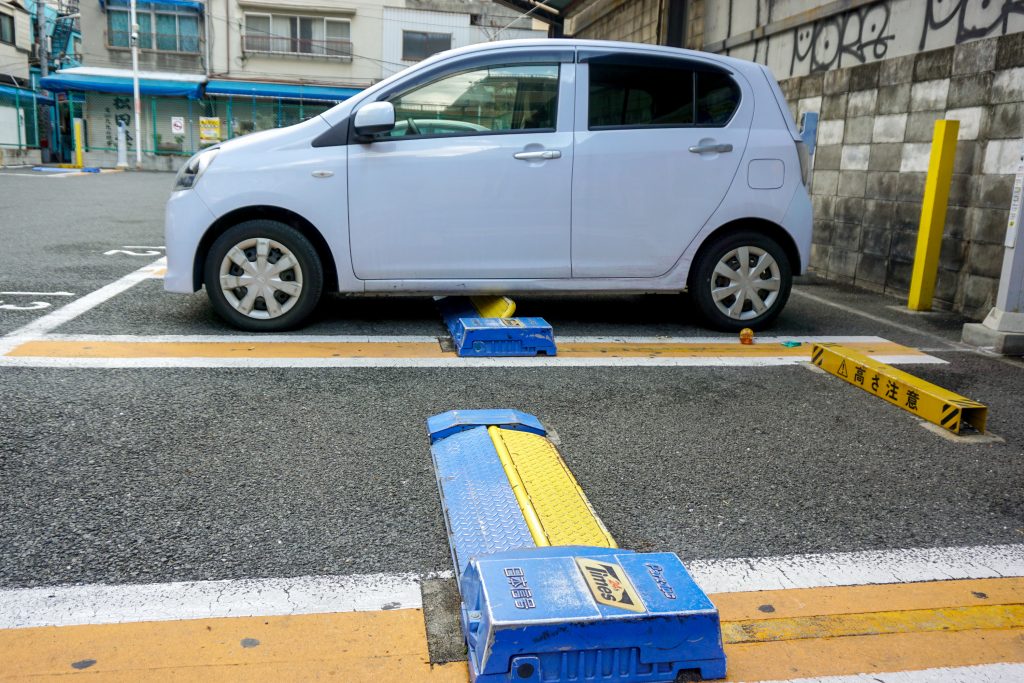
Elevator parking lots (car towers) – in such parking lots you are supposed to park your car in a special elevator. Once you get out of the car, the elevator will automatically take your car up in the tower and store it in one of its sections. Once you are back, the car will be returned to you with the elevator. Some of these towers have 10-15 floors.

Paying via fare adjustment machine
In order to pay the parking via a fare adjustment machine, you need to enter the parking space number and press the adjust payment button. You can use either cash or credit card when making the payment. In the end, you will also get a receipt. Once the payment is finalized the locking plate under your car will close and you will be able to drive away. Make sure to leave quickly after making the payment. Otherwise, the locking plate will engage and your car will be locked again.
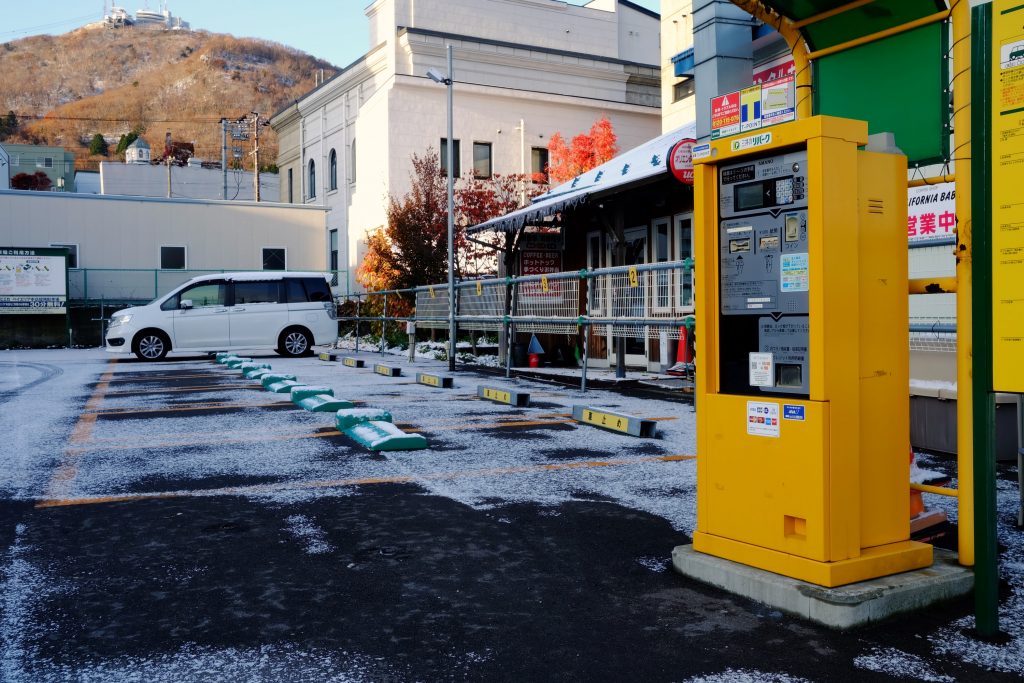
Parking violations
If you park illegally you will be notified by a notification sticker placed on your car. Parking officers (usually in green uniforms) check the streets often in order to spot the illegally parked vehicles. Additionally, police officers also look for parking violators. If they see your vehicle illegally parked they can also issue a fine. In some cases, they might lock the wheel of your vehicle and request a tow truck, which will then take it to the special parking (storage) area from which you can pick it up. But only after paying the fine, AND towing and storage fees.
Once you find out that you broke the rule, the best is to pay the fine immediately (you might need to go to the local police office). Keep all the documents collected throughout the process (including the ticket and the proof/receipt of payment). If you drove a rental vehicle you must present these documents at the rental counter upon returning the car. If you do not pay the penalty it will imply that you broke the Japanese law and your rental contract. You will be put in the “black list” of All Japan Car Rental Company Association. As a result, you will never be able to again rent a car in Japan.

Where not to park:
- Intersections
- Pedestrian/bicycle crossing zones
- Bus stops
- Fire hydrants
Refueling
Some gas stations in Japan are open 24 hours but many are closed at night. Most of the gas stations in Japan provide full-service (フル). Staff will help you fill up your tank. Often, they might suggest cleaning your windshield too. Knowing the basic Japanese words such as full-tank/half-tank, regular gasoline/diesel, cash/credit card etc. would be of great help.
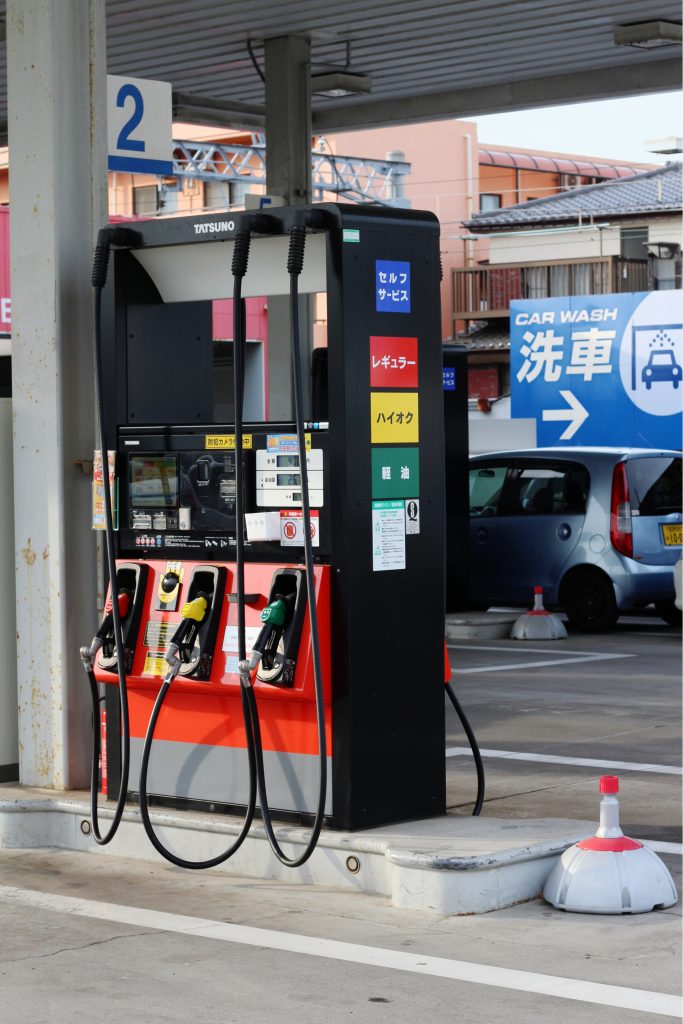
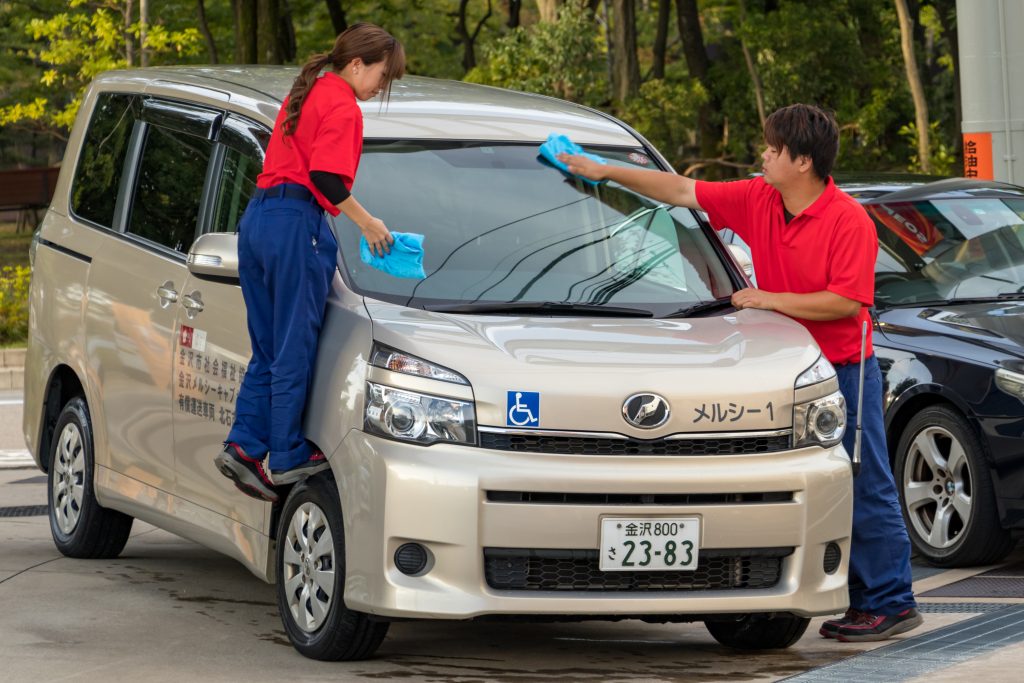
The number of self-service (セルフ) stations is also increasing. Be aware that the instructions will be written only in Japanese. If you have some difficulties understanding the procedure, there should be a staff member available for help. Let him/her know that you require help. If you choose to pay by cash remember that the change is sometimes given by a separate machine, which in some cases can be located inside the gas station building.


The average price for gasoline (octane-95) during the period of Oct 2019 – Jan 2020 ranged from 142.60 JPY (US$ 1.30) to 147.40 JPY (US$ 1.34) per liter. To give you an idea, the world average price of gasoline for the same period was 162.97 JPY (US$ 1.48) per liter.
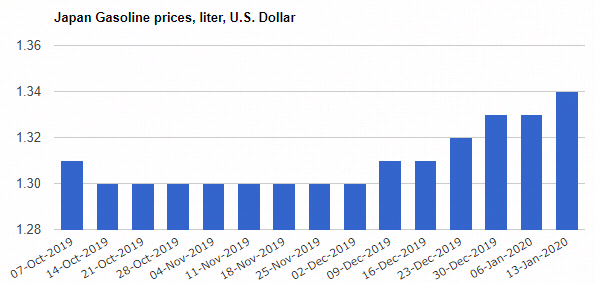
Source: https://www.globalpetrolprices.com/Japan/gasoline_prices/
Emergencies
Emergency phone numbers
119: Sudden sickness or injury / in case of fire
110: If you need a police officer
#7119: If you are not sure whether you should call an ambulance
All these numbers are toll-free. You can also use a public phone to call these numbers for free. Ambulances and fire trucks are free of charge.
Expressway/highway emergencies
If your vehicle breaks down on a highway, do not walk around on the road. Once you get out, set up warnings for the vehicles behind you, in case you want to change a tire or do another simple repair. Place an emergency warning marker (triangle), flare, and/or hazard lamps behind your vehicle. If a simple repair is not enough and you are forced to wait for help, the best is to move away from the road and wait behind the guardrail (this applies to all passengers in the car).
If you do not have a cell phone you can walk towards the emergency telephone (walk from behind the guardrail, never on the road). On the freeway, these can be found every kilometer and in tunnels every 200 meters. You can communicate the accident via emergency telephone. Once you pick up the phone it will directly connect you to a traffic control center. Alternatively, you could press the button that best describes the type of your emergency. Needless to say, the emergency telephones should be used only in case of an accident or a mechanical failure of your vehicle.
Neighborhood police – Kobans
In Japan, you can find many Kobans. These are small neighborhood police stations where officers are available 24 hours a day. They have a number of responsibilities including preventing crime, regulating traffic, giving directions, dealing with accidents, dealing with incidents and so on.

What to do in case of an accident?
If you get into an accident you are expected to do the following:
- Stop the car immediately and do not leave the place unless you are injured.
- If somebody is injured call 119 immediately, to request an ambulance.
- Install warning marker, flare, and/or hazard lamps. Choose their locations based on the position of your car.
- Call 110 to inform the police about the accident. Give them the information that they request.
- They will file an accident report, which you will need to claim compensation from your insurance company. Police will ask you to present your driving license, foreigner registration certificate (if you are not Japanese), vehicle inspection certificate (it must be up to date), vehicle insurance. They will classify the accident either as Damage Only Accident (busson jiko) or Personal Injury Accident (jinshin jiko). Later on, you will be able to obtain a certificate from the J


Hii,
I must tell you that this blog is so good and enough informative as well by this i came to know about many things related to Japan’s traffic rules with road symbols which would help me with the future if we tried to spread our business in Japan too. I would like to thank you to make us aware about the traffic rules of japan.
Amazing information. Thank-you for Sharing with us.
I simply couldn’t depart your site before suggesting that I actually enjoyed the usual information an individual supply for your visitors? Is gonna be again ceaselessly to inspect new posts
Amazin!
A Wrinkle In Time Book Series Pure Science Zoology Question Paper 2018
Also visit my blog post :: pdf (sharp-johnson-daf3ba.netlify.app)
Someone necessarily lend a hand to make critically posts I would state.
That is the first time I frequented your website page and thus far?
I amazed with the analysis you made to create this actual put up incredible.
Fantastic task!
Thank you for the sharing good knowledge and information its very helpful and understanding!
Thank you for sharing. It was useful. You can also visit my blog in related to this post https://towingcompanykingston.com
The sales ranking is a number that is specific to the Amazon.com system that is an indicator of how long it has actually been because an item last offered in connection to other items in it’s classification. The sales rank is a number that is certain to the Amazon.com platform that is an indicator of just how lengthy it has been given that an thing last offered in connection to other items in it’s classification. I recommend looking for products that have a sales ranking of less than 250,000 when you are getting began.
There is noticeably a bundle to find out about this. I assume you made certain nice points in features also.
Your house is valueble for me. Thanks!…
Excellent read, I just passed this onto a friend who was doing some research on that. And he just bought me lunch as I found it for him smile Therefore let me rephrase that: Thank you for lunch!
That is very attention-grabbing, You are a very skilled blogger. I’ve joined your feed and sit up for in the hunt for more of your fantastic post. Also, I have shared your site in my social networks!
certainly like your web-site but you need to check the spelling on quite a few of your posts. A number of them are rife with spelling problems and I find it very troublesome to tell the truth nevertheless I will definitely come back again.
Marie Lu Agent Debbie Macomber Manning Series
My site … wordpress.com, competentjones.netlify.app,
I appreciate, cause I found exactly what I was looking for. You have ended my 4 day long hunt! God Bless you man. Have a great day. Bye
I’ve been browsing online more than three hours today, yet I never found any interesting article like yours. It’s pretty worth enough for me. Personally, if all web owners and bloggers made good content as you did, the internet will be much more useful than ever before.
Very good written post. It will be supportive to everyone who usess it, as well as myself. Keep up the good work – can’r wait to read more posts.
Helpful information. Lucky me I discovered your site unintentionally, and I am shocked why this coincidence did not came about earlier! I bookmarked it.
My husband and i got now satisfied when Michael managed to round up his research via the ideas he received out of the site. It’s not at all simplistic to just possibly be freely giving methods which usually other folks may have been selling. So we do know we have the blog owner to be grateful to for that. The main explanations you made, the straightforward web site menu, the friendships you assist to promote – it’s many astonishing, and it’s really helping our son and our family understand that matter is awesome, which is certainly pretty serious. Thanks for the whole lot!
Good write-up, I am regular visitor of one’s web site, maintain up the nice operate, and It is going to be a regular visitor for a long time.
Really enjoyed this article, can I set it up so I receive an update sent in an email whenever you publish a fresh post?
Hi, I think your blog might be having browser compatibility issues. When I look at your website in Ie, it looks fine but when opening in Internet Explorer, it has some overlapping. I just wanted to give you a quick heads up! Other then that, excellent blog!
Spot on with this write-up, I truly suppose this website wants rather more consideration. I’ll most likely be again to read much more, thanks for that info.
There is clearly a bunch to realize about this. I consider you made some good points in features also.
Great news once again!
Amazin!
Amazin!
Hello my friend! I want to say that this post is awesome, great written and come with approximately all vital infos. I would like to look more posts like this .
This is really interesting, You are a very skilled blogger. I have joined your rss feed and look forward to seeking more of your fantastic post. Also, I have shared your web site in my social networks!
Hey! Would you mind if I share your blog with my myspace group? There’s a lot of people that I think would really enjoy your content. Please let me know. Cheers
Hiya, I’m really glad I’ve found this info. Today bloggers publish just about gossips and web and this is really frustrating. A good web site with interesting content, that’s what I need. Thank you for keeping this web-site, I’ll be visiting it. Do you do newsletters? Can’t find it.
Fantastic site. A lot of useful information here. I am sending it to several friends ans additionally sharing in delicious. And of course, thank you on your sweat!
I every time spent my half an hour to read this blog’s posts all the time
along with a mug of coffee.
Hello! This is my first comment here so I just wanted to give a quick shout out and say I really enjoy reading through your posts. Can you recommend any other blogs/websites/forums that deal with the same subjects? Thanks for your time!
I do enjoy the way you have presented this particular challenge plus it does indeed give me personally a lot of fodder for thought. On the other hand, coming from just what I have witnessed, I just simply trust as the remarks pile on that people keep on point and in no way get started on a soap box associated with the news du jour. Anyway, thank you for this fantastic point and though I can not really agree with this in totality, I respect the perspective.
I’ve been surfing on-line more than 3 hours as of late, but I by no means found any interesting article like yours. It’s beautiful price enough for me. Personally, if all site owners and bloggers made good content as you probably did, the internet might be a lot more helpful than ever before.
I love reading your site.
I truly wanted to write down a brief note in order to thank you for those fabulous concepts you are sharing here. My particularly long internet search has at the end of the day been honored with incredibly good strategies to go over with my co-workers. I would assert that we website visitors actually are unequivocally fortunate to dwell in a good website with so many awesome professionals with beneficial tricks. I feel really happy to have seen your website and look forward to many more fabulous times reading here. Thank you once more for all the details.
I must point out my gratitude for your kindness in support of women who must have assistance with your topic. Your real dedication to passing the solution across had been quite significant and has specifically allowed those much like me to arrive at their objectives. The invaluable tips and hints can mean much a person like me and a whole lot more to my peers. Many thanks; from everyone of us.
I relish, cause I discovered just what I was looking for. You have ended my four day long hunt! God Bless you man. Have a nice day. Bye
Thanks for another excellent article. Where else could anybody get that kind of information in such an ideal way of writing? I’ve a presentation next week, and I’m on the look for such info.
I in addition to my guys appeared to be checking the great advice located on the blog and so unexpectedly came up with an awful feeling I had not thanked the web blog owner for those strategies. The women are already as a consequence excited to see all of them and have quite simply been using these things. I appreciate you for actually being indeed kind as well as for deciding upon variety of wonderful ideas millions of individuals are really desperate to learn about. My personal honest regret for not saying thanks to you earlier.
I just like the valuable info you supply to your articles. I’ll bookmark your weblog and check once more here regularly. I’m quite sure I will be informed lots of new stuff proper here! Good luck for the following!
I really appreciate this post. I have been looking all over for this! Thank goodness I found it on Bing. You have made my day! Thanks again
Excellent beat ! I wish to apprentice at the same time as you amend your website, how could i subscribe for a weblog website? The account helped me a applicable deal. I had been a little bit familiar of this your broadcast offered bright clear idea
Great beat ! I would like to apprentice whilst you amend your web site, how can i subscribe for a weblog web site? The account aided me a applicable deal. I had been tiny bit familiar of this your broadcast provided bright clear idea
I have been surfing online more than three hours today, yet I never found any interesting article like yours. It is pretty worth enough for me. In my view, if all site owners and bloggers made good content as you did, the net will be a lot more useful than ever before.
Today, I went to the beachfront with my children. I found a sea shell and gave it to my 4 year old daughter and said “You can hear the ocean if you put this to your ear.” She placed the shell to her ear and screamed. There was a hermit crab inside and it pinched her ear. She never wants to go back! LoL I know this is completely off topic but I had to tell someone!
Hi! Do you know if they make any plugins to safeguard against hackers? I’m kinda paranoid about losing everything I’ve worked hard on. Any suggestions?
My brother recommended I might like this blog. He was totally right. This put up actually made my day. You cann’t consider just how so much time I had spent for this information! Thanks!
buy generic viagra online usa http://usggrxmed.com/ real viagra vs generic viagra buy viagra online without
Yesterday, while I was at work, my sister stole my apple ipad and tested to see if it can survive a 30 foot drop, just so she can be a youtube sensation. My iPad is now destroyed and she has 83 views. I know this is totally off topic but I had to share it with someone!